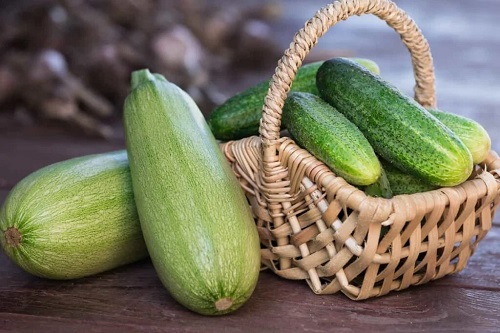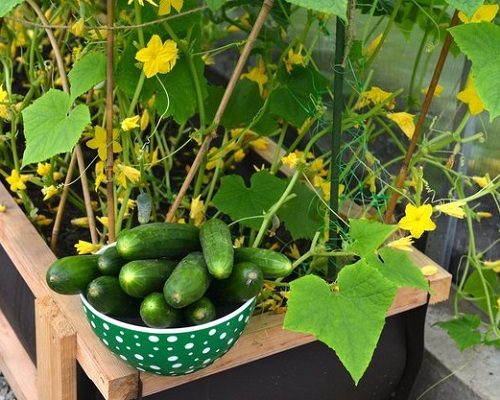Zucchini vs. Cucumber! Did you know these two favorites hold unique traits? Let’s learn how and broaden our understanding.
Curious about Zucchini vs. Cucumber? Let’s embark on a journey to explore the fascinating differences between these green vegetables.
Find out the difference between lilac and lavender here
What is Zucchini?
Zucchini, scientifically known as Cucurbita pepo, is a summer squash from the Americas, now grown globally in warm regions. It’s cultivated in spring and summer, peaking from late spring to early fall.
Rich in vitamins A and C, fiber, and minerals like potassium, it features a slim shape, smooth skin, and a mild sweet taste, making it versatile for various dishes.
What is Cucumber?
Cucumber, scientifically Cucumis sativus, is from the gourd family, Cucurbitaceae. Originating in South Asia, it now thrives worldwide in warm regions, cultivated mainly during warmer months.
With high water content, cucumbers are a hydrating snack, offering vitamins K and C, plus minerals like potassium. They vary in size and shape, are known for crispness, and are enjoyed in salads, sandwiches, and pickling.
Here’s all you need to know about growing cucumbers on trellises
Zucchini vs. Cucumber: Differences
1. Botanical Classification
- Zucchini: Part of the Cucurbita genus, zucchini is a summer squash. Being a type of squash, it is closely related to pumpkins and other squash varieties.
- Cucumber: Belongs to the Cucumis genus, cucumbers are classified as gourds. They are related to melons and other gourd family members.
2. Taste
- Zucchini: Mild and slightly sweet, zucchini’s taste becomes more pronounced when cooked. It absorbs flavors well, making it versatile in cooking.
- Cucumber: Known for a refreshing, crisp taste. Its cooling flavor is distinctive and is often enjoyed raw.
3. Texture
- Zucchini: Has a softer flesh that becomes tender when cooked. The skin is also edible but can be peeled if a softer texture is desired.
- Cucumber: Characterized by a crunchy texture, especially when fresh. The skin can be slightly tough, depending on the variety.
4. Appearance
- Zucchini: Generally darker green, though some varieties are yellow. Its skin is typically thinner and more delicate.
- Cucumber: Usually a lighter green color with a more waxy appearance. Some varieties may have ridges or bumps on the skin.
5. Shape
- Zucchini: Often more consistent in width along its length, with a slightly stubby appearance. The ends are usually rounded.
- Cucumber: Longer and more slender, with a consistent cylindrical shape. The ends are more pointed.
6. Nutritional Content
- Zucchini: Contains vitamin B6, riboflavin, and folate. It’s lower in calories and carbohydrates.
- Cucumber: Rich in vitamin K and potassium. Known for its high water content, it’s hydrating and low in calories.
7. Growth Conditions
- Zucchini: Thrives in warm soil and is typically harvested when immature. It grows on bushy plants with broad leaves.
- Cucumber: Prefers well-drained soil and full sun. It often grows on vines and may require support or trellising.
8. Culinary Uses
- Zucchini: Used in stir-fries, baked dishes, grilled, or spiralized for noodles. Can be eaten raw but often cooked.
- Cucumber: Primarily eaten raw in salads, sandwiches, or used in pickling. Its crisp texture is a key culinary feature.
June Bug vs Japanese Beetle: All the Differences
Zucchini vs. Cucumber – Conclusion
While both zucchini and cucumber are members of the same botanical family, their differences in taste, texture, appearance, shape, nutritional content, growth conditions, and culinary applications set them apart.
These differences reflect their unique characteristics, making them suitable for various culinary uses and preferences. Whether growing them in your garden or using them in your kitchen, understanding these distinctions can guide you in making the right choices for your needs.
FAQs
1. Can You Eat the Skin of Zucchini and Cucumber?
Yes, the skin of both zucchini and cucumber is edible. However, the texture and taste of the skin can vary between the two. Zucchini skin is thinner and can be left on, while cucumber skin can sometimes be tougher, so you might choose to peel it based on personal preference.
2. Are Zucchini and Cucumber Fruits or Vegetables?
Despite being commonly used in savory dishes, both zucchini, and cucumber are botanically classified as fruits. In botanical terms, a fruit is the mature ovary of a flowering plant, and both zucchini and cucumber fit this definition.
Vegetables that are Fruits – The List is Surprising!
3. Can You Substitute Zucchini for Cucumber in Recipes and Vice Versa?
While they have distinct textures and flavors, you can often substitute zucchini for cucumber and vice versa in certain recipes. However, keep in mind that their differences might slightly alter the taste and texture of the final dish.
4. Are There Any Health Benefits Unique to Zucchini or Cucumber?
Both zucchini and cucumber offer various health benefits, such as vitamins and minerals, but they also have some unique nutritional qualities. Zucchini contains vitamin B6 and folate, while cucumber is particularly known for its high water content, which can contribute to hydration.





